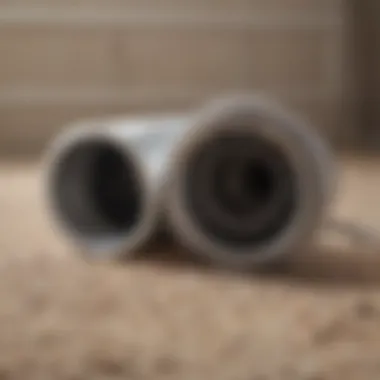The Importance of Dryer Vent Cleaning for Safety


Intro
Dryer vent cleaning is a topic that often does not receive the attention it deserves. Homeowners may neglect this essential task, unaware of the significant implications associated with inadequate dryer vent maintenance. Understanding the relevance of a clean dryer vent can lead to important decisions about home safety and the efficiency of appliances.
Firstly, it's crucial to recognize that dryer vents can accumulate lint, debris, and other materials over time. This buildup not only affects the lifespan of the dryer but also poses a fire hazard—a risk that is often overlooked. By regularly maintaining dryer vents, users can prevent fires, enhance energy efficiency, and ensure their appliances operate effectively.
In this article, I will delve deeper into the importance of dryer vent cleaning. We will discuss the potential fire hazards linked to dirty vents, examine energy consumption implications, and explore how maintenance influences the longevity of appliances. Each of these aspects contributes to a safer and more efficient living environment, particularly for homeowners who prioritize both safety and utility in their residences.
Prolusion to Dryer Vent Cleaning
Dryer vent cleaning is an essential task that often goes unnoticed in the average household. Many people assume that if the dryer seems to be working fine, there is no need for maintenance. This assumption is misleading. Regular cleaning of dryer vents is crucial for several reasons, primarily related to safety and efficiency. Dirty vents can pose significant hazards and cause the dryer to work harder, leading to increased energy costs.
Understanding Dryer Vents
Dryer vents are the passageways that vent hot air, moisture, and lint from the dryer to the outside of your home. Proper airflow is vital for the dryer’s function. When vents get clogged with lint, airflow is significantly reduced. This can cause the dryer to overheat, creating a risk of fire. Besides safety concerns, blocked vents also lead to less efficient drying cycles. A dryer has to run longer to dry clothes thoroughly, wasting energy and increasing utility bills. Regular maintenance of dryer vents not only ensures safety but also enhances the performance of the appliance.
Common Misconceptions
There are several misconceptions surrounding dryer vent cleaning that need to be addressed. For instance, many homeowners believe that if the dryer is not overheating or showing warning signs, it does not require cleaning. This is false. Lint build-up can occur gradually and may not always present immediate symptoms. Another misconception is that lint traps in dryers are sufficient to prevent buildup in the vents. In reality, while lint traps do capture a portion of lint, they do not catch everything. As a result, lint still escapes into the vent system, leading to potential blockages over time.
"Regular maintenance of dryer vents not only ensures safety but also enhances the performance of the appliance."
The Fire Hazard Factor
Dryers are commonplace in most households, but the risks associated with them often go unnoticed. Understanding the fire hazard factor related to dryer vents is essential. Clogged and unmaintained vents can lead to severe consequences, including devastating fires. This section emphasizes the importance of recognizing these hazards to enhance safety and efficiency in home environments.
Statistics on Dryer Fires
The statistics show a worrying trend regarding dryer-related incidents. According to the U.S. Fire Administration, approximately 2,900 dryer fires occur each year, resulting in multiple injuries and loss of life. These fires collectively cause tens of millions of dollars in property damage annually. The risk escalates significantly for those who neglect the cleaning and maintenance of their dryer vents.
- Leading Cause: Approximately 34% of dryer fires are due to failure to clean the vents adequately.
- Peak Months: Most dryer fires happen during winter months, coinciding with increased laundry loads but colder, dryer conditions that can promote lint accumulation.
- Residential Impact: Homes with uncleaned or improperly maintained vents are at higher risk for fire breakouts compared to those who follow regular maintenance schedules.
These figures illustrate the critical need for regular dryer vent cleaning as a preventive measure against potential fire hazards.
Causes of Dryer-Related Fires
Several factors contribute to dryer-related fires, primarily centered around lint accumulation and poor ventilation. The most common causes include:
- Lint Buildup: Over time, lint can accumulate in the dryer vent, restricting airflow and increasing the heat inside the dryer.
- Blocked Vents: A blocked vent can trap heat and lint, creating a fire hazard. This situation can arise from improper installation or neglect.
- Mechanical Failures: Faulty components, such as heating elements, can malfunction and ignite surrounding flammable materials.
- Inadequate Maintenance: Failure to follow the manufacturer’s recommendations for vent cleaning leads to higher risks.
"Regular maintenance of dryer vents is not just a matter of efficiency but a significant safety concern that can save lives."
Ignoring these potential causes can result in severe consequences, underscoring the necessity for proper vent cleaning and awareness.
Recognizing that dryer fires can be prevented through responsible maintenance is vital for homeowners. Implementing diligent cleaning schedules and understanding the risks can mitigate the likelihood of such hazards.
Energy Efficiency Considerations
Understanding the energy efficiency of dryers is essential in today’s climate. It not only affects household bills but also impacts the environment. As such, dryer vent cleaning should be a priority for homeowners seeking to maximize efficiency and minimize waste.


Increased Energy Consumption
One crucial aspect of energy efficiency relates to increased energy consumption caused by clogged dryer vents. When lint accumulates, it obstructs airflow. This obstruction forces the dryer to work harder, which results in excessive energy use. Data shows that a clean vent can reduce energy consumption by up to 30%. The dryer often cycles longer to dry clothes when the heat cannot escape because of a blocked vent. This added cycle time leads to higher energy bills and unnecessary wear on the appliance.
When choosing dryer vent maintenance, consider the physical signs that indicate the need for cleaning:
- Extended drying times
- Clothes remain damp after the drying cycle
- Overheating of the dryer
If these conditions persist, the energy efficiency of the appliance diminishes markedly. Addressing these issues through regular cleaning can lead to more effective energy use in the long term.
The Cost Implications
The cost implications of neglecting dryer vent cleaning extend beyond just heightened energy bills. While homeowners face increased costs from energy usage, the impact on appliance longevity should not be overlooked. A dryer that operates inefficiently can reach the end of its lifespan much sooner, resulting in premature replacement expenses. Purchasing a new dryer is not merely a financial burden; it also involves time and effort in researching and selecting the right model.
In addition, there are indirect costs associated with safety hazards. A dryer that becomes a fire risk due to lint buildup can lead to catastrophic outcomes. Homeowners might bear the costs of property damage and increased insurance premiums when incidents occur. Thus, spending on regular dryer vent cleaning is not merely a maintenance chore; rather, it is a proactive measure to avoid significant financial consequences in the future.
Keeping a clean dryer vent is essential for minimizing costs and maximizing appliance efficiency.
Impact on Dryer Longevity
Dryers serve essential functions in both commercial and residential settings. Their efficiency greatly influences daily routines and operational costs. However, their longevity can suffer significantly from negligence, particularly in the context of dryer vent maintenance. This section elaborates on how maintaining clean dryer vents is vital to prolonging the lifespan of the appliance.
Avoiding Excess Wear and Tear
Dirty dryer vents lead to numerous issues that can impact the wear and tear on the appliance. When lint and debris accumulate in the vent, airflow becomes restricted. This restriction makes the dryer work harder to expel moisture from clothes. The extra strain on the motor and heating elements causes them to wear out faster. Here are some key points on the negative effects of accumulated lint:
- Increased Energy Consumption: A blocked vent increases drying times, necessitating more energy to achieve the same results. Thus, the dryer becomes less efficient over time, leading to higher utility bills.
- Component Damage: Over time, overheating caused by blocked vents can lead to damaged components. The heating element, motor, and other internal parts can suffer, reducing their effectiveness and requiring costly repairs or replacements.
- Potential for Mechanical Breakdown: A dryer that continually operates under stress from blocked airflow is at a higher risk of eventual breakdown. Repairing these issues can be expensive and often leads to the decision to replace the entire unit instead.
Maintaining clean dryer vents not only ensures that the dryer operates efficiently but also helps in avoiding premature wear and excessive repair costs.
Manufacturer Recommendations
Manufacturers typically provide guidelines for appliance care, including recommendations for dryer vent cleaning. Following these recommendations is crucial for several reasons:
- Warranty Validity: Many manufacturers stipulate that regular maintenance is required to keep warranties valid. Neglecting vent cleaning can void warranties and leave owners responsible for repairs.
- Optimal Performance: Manufacturers design their dryers with specific airflow requirements. Clean vents ensure that these requirements are met, providing optimal performance and extending the lifespan of the dryer.
- Safety Guidelines: Leading manufacturers like Whirlpool and GE advocate for vent maintenance as a part of safety protocols. This highlights how vital maintaining the appliance is not only for longevity but also for overall home safety.
Signs That Your Dryer Vent Needs Cleaning
Identifying the signs that indicate your dryer vent requires cleaning is essential for maintaining safety and efficiency. Over time, lint and debris accumulate in the vent, obstructing airflow. This limitation can lead to various issues including fires, inefficient drying, and increased energy bills. Awareness of these signs enables homeowners to act promptly.
Unusual Drying Times
One of the first indicators that your dryer vent may need cleaning is an increase in drying times. If clothes take significantly longer to dry than when the appliance was new, this could signal a blockage. The dryer has to work harder to push air through the vent, which not only consumes more energy but can also overheat components, posing safety risks. Timely intervention is crucial to avoid further complications.
Burning Smell from the Dryer
A burning smell emanating from your dryer is a dangerous sign and should never be ignored. This odor often results from lint buildup inside the dryer or vent, causing overheating. If left unattended, this situation can lead to a serious fire hazard. Disconnecting the dryer and inspecting the vent and the machine itself for lint accumulation is vital. If the smell persists after cleaning, it's smart getting a professional to examine the dryer.
Fluffy Lint Accumulation
Visible lint buildup around the dryer’s lint trap or at the exit point of the vent is a clear sign of improper vent cleaning. Aside from being an aesthetic issue, this accumulation can impede airflow, which is critical for efficient drying. Regular checks of this area help ensure that excess lint is removed, reducing risks associated with dryer fires. If you notice that the lint trap fills up disproportionately quickly, your vent likely requires cleaning.


Regular inspection of your dryer vent can prevent significant issues, ensuring your appliance runs efficiently and safely.
The Process of Dryer Vent Cleaning
Understanding the process of dryer vent cleaning is essential for maximizing safety and efficiency in your home. It involves systematic approaches that can either be executed by homeowners or carried out by professionals. The significance of this cleaning process cannot be overstated, as it directly influences fire prevention, energy savings, and appliance longevity.
DIY Cleaning Techniques
For those inclined to handle their dryer vent cleaning, several techniques can be employed. A DIY approach can save money and provide a sense of accomplishment. Here are some steps to conduct effective cleaning:
- Gather Necessary Tools:
- Disconnect the Dryer:
- Access the Vent:
- Vacuuming and Brushing:
- Reassemble and Test:
- A vacuum cleaner equipped with a long hose attachment
- A dryer vent cleaning brush that fits the vent diameter
- Screwdriver for vent cover removal
- Duct tape for sealing
- Important for safety, start by unplugging the appliance from the power source. This reduces risk during the cleaning process.
- Remove the dryer vent cover from outside if applicable. This will allow for a thorough clean from both inside and the exterior.
- Insert the vacuum hose into the vent. Clean any lint or debris.
- Use the brush to reach deeper areas of the vent.
- Reconnect the vent and plug your dryer back in.
- Run the dryer for a short time and keep an eye for airflow quality.
These steps, while straightforward, require diligence and care. Regular inspection and cleaning can help a homeowner catch issues early.
Professional Cleaning Services
While DIY methods can be effective, enlisting professional cleaning services offers various advantages. These specialists possess the tools and expertise for a more comprehensive cleaning experience. Here’s an overview of what to expect from such services:
- Expert Assessment: Professionals typically evaluate the entire dryer vent system. They can identify areas needing attention beyond simple lint buildup.
- Specialized Equipment: Professionals use advanced tools, like high-powered vacuums and rotary brushes, designed to reach blockages.
- Safety Assurance: Trained technicians follow appropriate safety standards, ensuring that risks associated with electrical components and fire hazards are held to a minimum.
- Comprehensive Solutions: Post-cleaning, many services provide guidance on maintenance schedules, helping homeowners understand when their vents need to be cleaned again.
Even if the initial cost of professional services is higher than a DIY attempt, the long-term benefits, including peace of mind and the reduction of hazards, are important.
Regular dryer vent maintenance is not merely an option; it is crucial to prevent fire hazards and enhance energy efficiency, protecting both your home and your wallet.
Frequency of Dryer Vent Cleaning
Understanding how often you should clean your dryer vent is essential. The frequency of cleaning impacts not only safety but also efficiency. Regular maintenance keeps your home safe from fire hazards, reduces energy costs, and prolongs the life of your dryer. Neglecting this task can lead to severe problems, including decreased performance and increased risks.
General Guidelines
There are general rules to follow regarding how often to clean your dryer vent. Typically, the recommendation is to clean the vent at least once a year. This is a baseline to ensure that lint and debris do not accumulate to dangerous levels. However, several factors may necessitate more frequent cleaning.
Consider these guidelines:
- Use Patterns: If you do laundry multiple times a week, you may need to clean more often.
- Dryer Age: Older dryers are more prone to issues and may require closer monitoring.
- Excess Lint: If you notice an accumulation of lint or find that your dryer is not running efficiently, it's time to clean.
Factors Influencing Frequency
Several variables can influence how often you should clean your dryer vent.
These include:
- Type of Clothing Dried: Heavy fabrics like towels and bedding create more lint. If you frequently dry these items, plan for a cleaner vent.
- Home Environment: Homes with pets may experience more debris. The fur from pets can mix with lint, creating blockages.
- Vent Configuration: Long or complicated vent systems may trap lint more easily. In such cases, more frequent maintenance is crucial.


"Regular cleaning not only ensures safety but also enhances the efficiency of your dryer, saving both time and money in the long run."
By adhering to these guidelines and considering the influencing factors, you can maintain a safe environment and ensure the longevity of your appliance. Regularly cleaning your dryer vent is an investment in your home’s safety and efficiency.
Regulatory Standards and Guidelines
Regulatory standards and guidelines are essential in governing dryer vent cleaning practices. These rules not only set the minimum safety requirements but also ensure that residential and commercial spaces adhere to efficient operational standards. Compliance with these guidelines protects property and lives. Knowing what regulations exist helps in making informed decisions about maintenance.
National Fire Protection Association Guidelines
The National Fire Protection Association (NFPA) provides crucial guidelines related to fire safety concerning dryer vents. Their recommendations include regular maintenance of dryer vents to mitigate the risk of fires caused by lint buildup. The NFPA suggests that homeowners should clean their dryer vents at least once a year. Some properties with heavy usage might require more frequent cleaning. Following these recommendations reduces the risk of fire hazards substantially.
Additionally, the NFPA highlights the importance of proper installation of dryer vent systems. It advocates for straight venting routes with minimal bends, which can trap lint and moisture, leading to operational inefficiency and increased fire risks. Adhering to these guidelines ensures effective airflow, reducing lint accumulation.
Local Building Codes
Local building codes often reflect or build upon NFPA recommendations, tailored to regional needs and safety concerns. These codes might specify the types of materials that can be used for dryer vents, emphasizing the use of smooth, non-combustible materials. This is crucial, as certain materials can pose additional risks if they are not aligned with established standards.
Homeowners and property managers must familiarize themselves with local building codes. Non-compliance can lead to penalties and, more importantly, unsafe living conditions. Regular inspections can verify if maintenance meets these codes.
In summary, understanding the regulatory framework surrounding dryer vent cleaning is fundamental. It not only emphasizes safety but also promotes efficiency and long-term performance of the appliances involved.
Additional Benefits of Regular Maintenance
Maintaining your dryer vent is not just about preventing fires or saving energy; it brings several other substantial benefits that are often overlooked. Regular cleaning of dryer vents promotes a healthier home environment and enhances dryer efficiency, leading to long-term savings. The significance of these benefits often resonates with homeowners who value both safety and cost-effectiveness.
Improved Indoor Air Quality
One key advantage of regular dryer vent cleaning is the improvement in indoor air quality. Lint accumulation and other debris can lead to airflow issues, which may cause particles to escape back into your living space. This can create an environment that is not ideal for respiratory health. When your dryer ventilates properly, it reduces the likelihood of lint and dust spreading throughout your home.
Studies have shown that poor air quality can lead to various health issues. In rooms where dryers operate, contaminants may become trapped due to obstructed ventilation. Regular maintenance ensures that the vents are clear and functioning properly, thereby improving air quality significantly. Homeowners can breathe easier knowing that their indoor environment is safer.
Performance Improvement
Another significant aspect of dryer vent cleaning is the performance improvement of the dryer unit itself. A clean vent allows for optimal airflow, which enhances the drying process. When a dryer operates under ideal conditions, clothes dry faster, saving time and energy.
Over time, a clogged vent can lead to extended drying cycles, which not only wastes energy but increases wear and tear on the appliance. Keeping the vent free from lint and debris can enhance the dryer’s efficiency. Furthermore, manufacturers often recommend regular cleaning to meet warranty conditions, preserving the longevity of the appliance.
In summary, the benefits of regular dryer vent maintenance extend beyond immediate safety concerns. Improved indoor air quality and enhanced performance contribute to a better overall living environment. Neglecting these aspects can lead to larger issues, both in terms of safety and appliance functionality. By prioritizing cleaning, homeowners can enjoy a healthier atmosphere and more dependable laundry appliances.
Culmination: Prioritizing Dryer Vent Cleaning
Dryer vent cleaning stands as a critical aspect of home maintenance that is often neglected. Understanding why it matters is essential for both safety and efficiency. The ramifications of ignoring this task can be severe. From increased fire risk to suboptimal appliance performance, the consequences extend beyond mere inconvenience.
Final Thoughts on Maintenance Importance
Regular maintenance of dryer vents ensures their optimal function. When lint and debris accumulate, they obstruct airflow. This can lead to overheating and potentially cause fires. Statistics suggest that nearly 17,000 dryer fires occur yearly in the United States. Such alarming figures emphasize the need for consistent attention to this aspect of home care. By maintaining clean vents, homeowners can proactively reduce this risk while promoting energy efficiency.
In addition, regular cleaning improves dryer lifespan. When vents are blocked, the dryer works harder. This excessive strain can lead to faster wear and tear, ultimately shortening the appliance's life. The relationship between appliance health and proper vent maintenance cannot be overlooked.
Advocating for Safety and Efficiency
Advocating for safety through dryer vent cleaning is not merely about compliance with standards; it is about personal responsibility. Homeowners should recognize that routine checks and cleanings are a commitment to the health of their indoor environment. Improved air quality often results from proper dryer vent management. Dust and allergens trapped within dirty vents can circulate back into the home. This poses risks for those with respiratory issues.
Moreover, efficient drying cycles contribute to reduced energy bills. A clean dryer vent allows the appliance to function more effectively, requiring less energy and time to dry clothes. This not only saves money but also contributes to environmental sustainability.
In summary, prioritizing dryer vent cleaning is crucial. Both safety and efficiency are significantly enhanced through proper maintenance. By making this a priority, homeowners can enjoy peace of mind and an effective appliance that enhances their living conditions.







